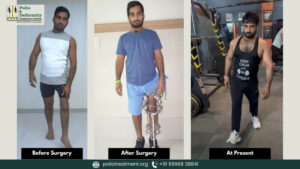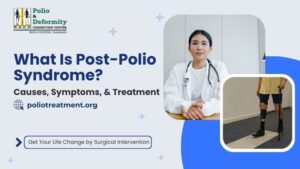Did you know that polio once caused thousands of children in India to become paralyzed for life? It was a disease that scared every parent, as there was no cure—only prevention. Thankfully, due to one of the biggest vaccination drives in history, India was declared polio-free in 2014. But there are still many facts about polio virus that people don’t know.
Even though India has eradicated polio, the virus still exists in some countries, and there is always a risk of it coming back. Since polio spreads easily, continued vaccination and active surveillance are the only way to ensure that our country stays safe and polio-free.
In this blog, you will explore some amazing and shocking facts about polio virus, including how it spreads, its impact, and the efforts to eliminate it worldwide.
Keep reading to learn why polio is still a serious concern and how we can protect future generations!
What Is the Polio Virus?
The polio virus is a member of the Enterovirus genus and belongs to the Picornaviridae family. It is a highly contagious virus that primarily affects the nervous system, potentially leading to paralysis. The virus spreads through contaminated food and water. Once it enters the body, it multiplies in the intestines and can attack nerve cells, leading to severe health complications. There are three known strains of polio virus:-
Type 1: The most common and primary cause of wild polio outbreaks.
Type 2: Declared eradicated globally in 1999.
Type 3: Officially eradicated in 2019.
Although the two strains are no longer in circulation, Type 1 remains a concern in some parts of the world, particularly in Afghanistan and Pakistan.
How Is Polio Virus Transmitted?
Polio is primarily transmitted through the feco-oral route, meaning the virus spreads when contaminated food or water is consumed. Poor sanitation, lack of clean drinking water, and inadequate hygiene practices contribute to the spread of the virus.
Risk factors for polio transmission include:-
- Poor sanitation and hygiene.
- Lack of immunization.
- Crowded living conditions.
- Malnutrition leads to weakness of the immune system.
Polio outbreaks often occur in areas with low vaccination rates, making immunization crucial in preventing its spread.
Symptoms of Polio Virus
Polio symptoms vary depending on the severity of the infection. Many cases are asymptomatic, meaning the virus infects individuals without causing noticeable symptoms. However, symptomatic cases can be classified into mild and severe forms:
Mild Symptoms
These include fever, sore throat, nausea, vomiting, fatigue, and muscle weakness. Some people may experience flu-like symptoms that last a few days.
Severe Symptoms
In more serious cases, the virus attacks the nervous system, leading to paralysis, muscle weakness, and breathing difficulties. Post-polio syndrome can occur years after recovery, causing further complications.
Children under five years old are most at risk of developing severe symptoms, making early detection and vaccination critical.
Also Read:- Post-Polio Syndrome
7 Major Facts About Polio Virus
The polio virus has shaped history in many ways, from causing widespread fear to leading one of the biggest global vaccination movements. Here are some shocking facts about polio virus that you may not know.
1. Polio Has No Cure, Only Prevention
Once a person is infected with the polio virus, there is no specific cure to eliminate it from the body. Medical treatments can only manage symptoms, such as physical therapy for paralysis and supportive care for breathing difficulties. The only way to prevent polio is through timely vaccination, which helps the immune system build resistance against the virus before exposure.
2. It Primarily Affects Children Under 5 Years Old
Polio is known as a pediatric disease because it mainly affects children under five years of age. Their immune systems are still developing, making them more vulnerable to infections. That’s why global immunization programs, including India’s Pulse Polio campaign, prioritize young children to ensure they develop lifelong immunity against the virus.
3. Polio Can Cause Permanent Paralysis in a Matter of Hours
The polio virus attacks the nervous system, and in severe cases, it can destroy motor neurons within hours of infection. It leads to irreversible paralysis, usually in the legs, and in rare cases, it can affect the muscles used for breathing. About 1 in 200 polio infections result in permanent paralysis, making it one of the most feared aspects of the disease.
4. The Last Case of Wild Polio in India Was in 2011
India, once considered one of the toughest places to eradicate polio, reported its last wild polio case in January 2011 in West Bengal. After years of dedicated vaccination efforts, India was officially declared polio-free by the World Health Organization (WHO) in 2014. This success story is now used as a model for other countries still struggling with polio outbreaks.
5. Two Types of Polio Vaccines Exist—OPV and IPV
Two types of vaccines protect against polio: the Oral Polio Vaccine (OPV) and the Inactivated polio vaccine (IPV). OPV, given as drops (2 boond jindgi ki), is widely used in mass immunization campaigns due to its easy administration and ability to provide community protection. IPV, given as an injection, is more effective at preventing polio in individuals. But, it needs to be given by expert health care workers and can not be administered at the community level. Both vaccines play a crucial role in global polio eradication efforts.
6. Some Polio Survivors Rely on Iron Lungs for Breathing
In severe cases, polio can paralyze the muscles used for breathing, leading to respiratory failure. Before modern ventilators, many polio survivors had to live inside an “iron lung”—a large metal chamber that helps them breathe using air pressure changes. Although rare today, some polio survivors in developed countries still depend on iron lungs due to long-term complications from the disease.
7. Afghanistan and Pakistan Are the Last Polio-Endemic Countries
While most of the world has eradicated polio, Afghanistan and Pakistan are the only two countries where wild polio cases are still reported. The main challenges in these nations include vaccine resistance, political instability, and difficulties in reaching remote areas. Despite ongoing vaccination efforts, polio remains a public health threat, proving that the fight against this disease is not over yet.
Polio Vaccination and Prevention
After knowing the key facts about polio virus, you should also learn about polio vaccination and prevention. Vaccination is the most powerful way to prevent polio. Two types of vaccines are used worldwide:-
- Oral Polio Vaccine (OPV): A live, weakened virus administered orally, offering community-wide immunity.
- Inactivated Polio Vaccine (IPV): An injected, inactivated virus that provides individual protection.
India’s success in polio eradication was largely due to massive immunization programs, including National Immunization Days (NIDs) and Subnational Immunization Days (SNIDs). The WHO’s Global Polio Eradication Initiative (GPEI) continues to push for worldwide eradication.
The Global Fight to Eradicate Polio
Many countries have successfully eradicated polio through mass vaccination campaigns. India was declared polio-free in 2014, thanks to rigorous efforts by the government and organizations like WHO and UNICEF. However, challenges remain in countries where polio persists. Some barriers include vaccine hesitancy, misinformation, and logistical challenges in war-torn regions. The Bill & Melinda Gates Foundation has been instrumental in funding eradication programs, ensuring vaccines reach vulnerable populations.
Post-Polio Syndrome: A Lesser-Known Effect
Many polio survivors experience post-polio syndrome (PPS) decades after recovering from the initial infection. PPS is characterized by:
- Muscle weakness and fatigue.
- Joint pain and mobility issues.
- Breathing difficulties.
- Change in posture and gait.
- Difficulty in walking or standing.
- Muscular strength starts deteriorating day by day.
Although PPS is not contagious, it can significantly impact the quality of life of polio survivors. Awareness and support systems for those affected are essential.
Get the Best Polio Treatment & Deformity Correction at India’s Leading Hospital
Polio may be eradicated from India, but its impact still lingers in the lives of many who have post-polio paralysis and deformities. If you or your loved one is struggling with polio-related complications, cerebral palsy, CTEV, or other neuro-muscular deformities, expert treatment can make a world of difference.
At the Polio and Deformity Correction Centre (PDCC), Bhola Hospital, Kurukshetra, we have been transforming lives for over 35 years. Located in the heart of the holy city of Kurukshetra, our Best Polio Treatment Hospital In India offers advanced treatments, corrective surgeries, and rehabilitation programs tailored for polio survivors and individuals with locomotor deformities.
Why Choose Polio & Deformity Correction Centre, Bhola Hospital?
- 35+ years of excellence in treating polio-related conditions
- Specialized in neuro-muscular and locomotor deformities
- Expert orthopedic & rehabilitation care to restore mobility
- State-of-the-art facilities for corrective surgeries and therapy
At PDCC, Bhola Hospital, we are dedicated to helping patients walk again and regain their independence. If your loved one needs specialized care, don’t wait—reach out to us today and take the first step towards a better life!
Visit us in Kurukshetra, or contact us now for expert consultation!
Final Thoughts
Polio remains a global health challenge, but with continued awareness and vaccination efforts, complete eradication is possible. Understanding the facts about polio virus can help individuals recognize the importance of immunization and hygiene practices. India’s success in eliminating polio proves that collective action can make a difference. By supporting vaccination programs and spreading awareness, we can ensure a polio-free future for generations to come.
FAQs
What are the main symptoms of polio virus?
Mild symptoms include fever, sore throat, and nausea, while severe cases can lead to paralysis and breathing difficulties.
Which countries still have polio?
Polio remains endemic in Afghanistan and Pakistan due to vaccine accessibility challenges.
Why is polio vaccination important?
Vaccination prevents infection and stops the spread of the virus, ultimately leading to its eradication.
Can polio be cured?
No, there is no cure for polio. Prevention through vaccination is the only way to protect against the virus.




